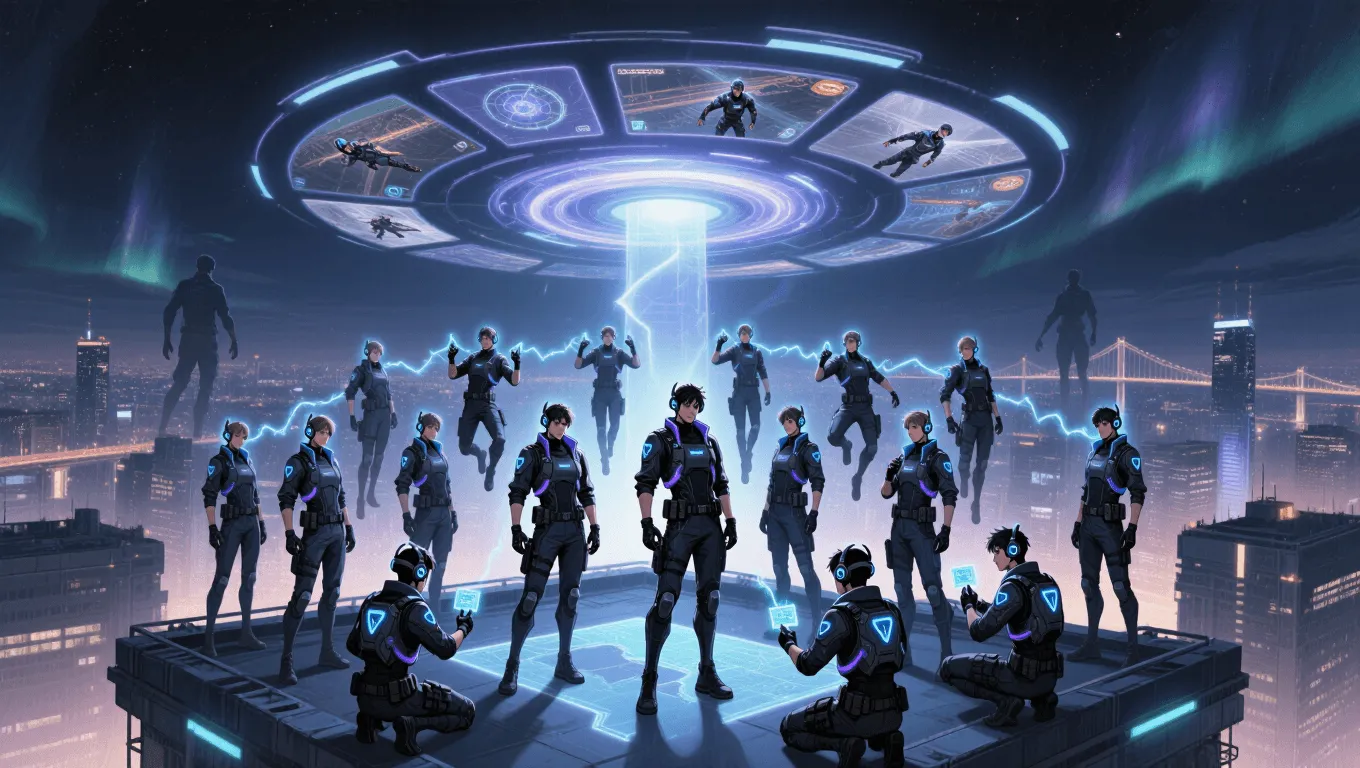Psychic Link: The Ultimate Team-Mind Connection

Psychic Link Video Demo 🎬
Table of Contents
Psychic Link is a superpower that creates a stable telepathic bond between two or more minds, allowing instant sharing of thoughts, senses, emotions, and tactical intent. Unlike general telepathy, which reads or projects thoughts one-way, a Psychic Link functions as a secure channel that all linked participants can use at once. When mastered, it can synchronize entire squads, amplify individual powers, and enable silent coordination that outpaces radios and hand signals by whole seconds—enough to decide the outcome of a fight. For a broader overview of related abilities, see the superpower wiki and for inspiration or try the random superpower generator.
What Is Psychic Link
A Psychic Link is a persistent, consent-based connection between minds. It may be formed by a telepath, a psionic device, or a natural resonance between individuals who share compatible brainwaves or psychic frequencies. Once established, the link transmits information bi-directionally. That information can include verbalized thoughts, flashes of memory, live sensory feeds (sight, sound, pain, pressure), and even higher-level intent—such as a plan or an instinct—without the need to translate it into words.
Unlike raw telepathy, a Psychic Link emphasizes stability, privacy, and synchronization. Participants can remain connected across distance, sometimes across dimensions, depending on the user’s level. The link can carry emotional context, allowing teammates to feel each other’s urgency, confidence, or fear, which improves group cohesion and reaction speed. The bond can be closed by mutual consent or by the initiator, and in some variants, it persists even when a member is unconscious.
Core Abilities of Psychic Link
Shared Thoughtstream
Participants communicate silently and instantly. The thoughtstream reduces misunderstandings and enables simultaneous planning, with no need for handoffs. Leaders can broadcast strategy; specialists can insert real-time observations directly into the group’s decision loop.
Sensory Merging
Linked members can selectively merge senses—sharing peripheral vision during a sweep, stacking audio feeds to triangulate a sniper, or letting a flier lend an aerial view to ground allies. Some advanced users can create a composite “hive view” that stitches multiple perspectives into one mental panorama.
Emotional Synchronization
The link can smooth panic, bolster morale, and transmit resolve. A calm expert can dampen the group’s fear response during a high-stress breach. Emotional sync must be carefully tuned; over-integration can cause empathy overload.
Cognitive Load Balancing
Complex calculations, pattern recognition, and memory recall can be distributed. One member might recall a code, another tracks enemy positions, while a third projects timing—together, the group thinks like a single efficient mind.
Latent Power Echo
If linked members have other psionic talents—like telekinesis, clairvoyance, or empathic reading—the link can echo and lightly reinforce those abilities for the entire group, enabling small boosts and cross-training effects.
Silent Command and Failover
If a leader is incapacitated, the link can hand off command intent to a secondary member, preserving the team plan without hesitation. The failover feature is a key strength in chaotic situations.
Application / Tactical Advantages in Combat
A Psychic Link transforms a team into a coordinated machine. Room clearing becomes safer because everyone updates angles and threats instantly. In stealth, no comms chatter reveals positions. During crowd control, linked heroes can stagger non-lethal actions in tight cadence without signals. In open combat, the link allows dynamic role-swapping: a defender senses when to shield a striker, a sniper knows when the distraction hits, and a healer moves the instant damage spikes.
The link also defeats many common battlefield problems. Jamming equipment does not block it unless there’s specific anti-psionic interference. Language barriers vanish. Even complicated maneuvers—like simultaneous flanks tied to a timed power surge—become routine. On the flip side, over-reliance can be dangerous: if the link is disrupted mid-execution, timing can unravel.
Level: Power Progression
Level 1 🏙️
At entry level, a user can link with one other person at a short range (line of sight or within a building). The connection supports thought-to-thought messaging and basic emotional pings. Sensory sharing is brief and partial—think “peek” moments, like lending a quick visual angle. Duration is minutes to an hour, and both parties must be conscious and willing. This level is excellent for stealth pairs, recon partners, and duo takedowns.

Key traits:
-
Two-person bond
-
Short range
-
Basic thought sharing
-
Momentary sensory snapshots
-
Requires consent and concentration
Level 2 🌇
With training, the user links small squads (3–7 members) over neighborhood-wide distances. Sensory merging can run continuously in low bandwidth (e.g., sharing motion cues or compass bearings), and high-bandwidth bursts are possible for critical moments. Emotional sync stabilizes group morale during sustained operations. Light cognitive load balancing kicks in—members can “park” a memory with a teammate. Duration extends to hours, with modest interference resistance.

Key traits:
-
Squad-scale network
-
City-block range
-
Ongoing low-bandwidth senses, burst high-bandwidth
-
Emotional dampening and morale sharing
-
Partial load balancing for memory and scanning
Level 3 🌃
At mastery, the user supports platoon-scale links (8–30+) across city or cross-border ranges and, in rare cases, across dimensions where psychic resonance is strong. The group can construct a fused tactical “hive view,” representing a 360° shared situational awareness with predictive cues. Emotional synchronization becomes a stabilizing field. Cognitive load balancing enables distributed analysis (e.g., cracking an enemy tactic mid-fight). The link tolerates pain, shock, and some mind-scrambling attempts, and can persist if members are stunned.

Key traits:
-
Large multi-team network
-
Citywide to trans-dimensional reach (variant-dependent)
-
Composite hive view with predictive assistance
-
Strong resilience to stress and interference
-
Seamless command failover and role fluidity
Limitations of Using the Psychic Link
-
Consent and Compatibility: Most forms require mutual consent or at least non-resistance. Hostile minds may reject the link or create feedback. Some individuals with unusual neurology or psychic shielding cannot be linked without risk.
-
Bandwidth and Noise: Minds are noisy. High-bandwidth sharing—full sensory streams, layered memories, emotional surges—can cause overload. Skilled users learn to filter channels, prioritize alerts, and silence background thoughts.
-
Cross-Contamination: Emotions and pain can spill over unintentionally. In prolonged battles, shared fatigue and stress can accumulate. If a member suffers trauma, echoes can distract or incapacitate the group.
-
Signal Range and Barriers: Physical distance, lead-lined structures, Faraday cages tuned for psionics, or anti-psychic fields can weaken or sever the link. Dimensional boundaries may scramble synchronization without special training.
-
Single Point of Failure (for some variants): If the initiator is knocked out or mind-jammed, the link may collapse unless configured with distributed failover.
-
Privacy and Ethical Risks: Even with filters, intimate details can leak during spikes of emotion. Teams need protocols for consent, redaction, and decompression—especially after sharing traumatic content.
-
Cognitive Fatigue: Maintaining a complex network drains mental stamina. Overuse can cause migraines, confusion, or short-term memory issues, requiring recovery time.
Weakness Against What Other Superpowers
-
Mind Shielding / Psychic Barriers: Dedicated defenses can block initiation or throttle bandwidth, reducing the link to shallow pings at best.
-
Empathic Overload / Emotion Amplification: Villains who spike fear, rage, or despair can flood the network. A linked team might all experience the surge at once if filters fail.
-
Neural Disruption / Psionic Scramble: Powers that desynchronize brainwaves—like psychic static, disruptive sonics tuned to neural patterns, or technopathic jammers—can cause lag, desync, or painful feedback.
-
Illusion Casting / Memory Distortion: If an adversary injects false images or altered memories into one member, the lie may propagate through the link unless authentication cues are in place.
-
Reality Warping Fields: Severe reality shifts can misalign sensory feeds and intent translation, forcing the link to fall back to low bandwidth.
-
Isolation Fields / Null Zones: In anti-psionic or null-magic zones, the link may drop completely, fragment, or become one-way.
Synergistic Power Combos
-
Clairvoyance or Precognition: Combining Psychic Link with limited foresight lets a team align actions with predicted outcomes, trimming reaction times and avoiding bad lines of play.
-
Telekinesis and Force Fields: A defender can pre-shape barriers in sync with a striker’s moves, catching shrapnel and shielding angles the instant a risk appears in the shared view.
-
Technopathy: With a technopath on the link, live sensor data, drone feeds, and system alerts stream into the group’s mental HUD. This creates a digital-psychic fusion layer that outperforms either alone.
-
Enhanced Agility and Hyper Awareness: Physical specialists gain a strategic overlay, calling out beats for parkour routes, crowd flows, and micro-timing in melee.
-
Healing Touch or Regeneration: Medics feel damage spikes through the link and triage instantly. In advanced teams, a healer can nudge pain perception to keep morale steady without dulling critical reflexes.
-
Illusion Casting (Allied): Friendly illusions are tagged with mental “authenticity marks” in the link so teammates know what’s fake for deception operations, while enemies are fooled.
Known Users
-
Jean Grey — a premier telepath in superhero fiction whose teamwork feats often hinge on deep mental coordination. Learn more about Jean Grey.
-
Martian Manhunter — a classic example of a high-tier telepath capable of group-wide links and battlefield orchestration. See J’onn J’onzz.
-
Saturn Girl — noted for founding-team telepathy and coordinated strategies in future-set stories. Explore Saturn Girl.
-
Emma Frost — known for precise, disciplined linking and tactical leadership. Read about Emma Frost.
-
Psylocke — often depicted using tactical telepathy to anchor squads in high-intensity skirmishes. Discover Psylocke.
For more powers that pair well with Psychic Link, browse the evolving catalog on superpower wiki, or spin up new character concepts with the random superpower generator.
